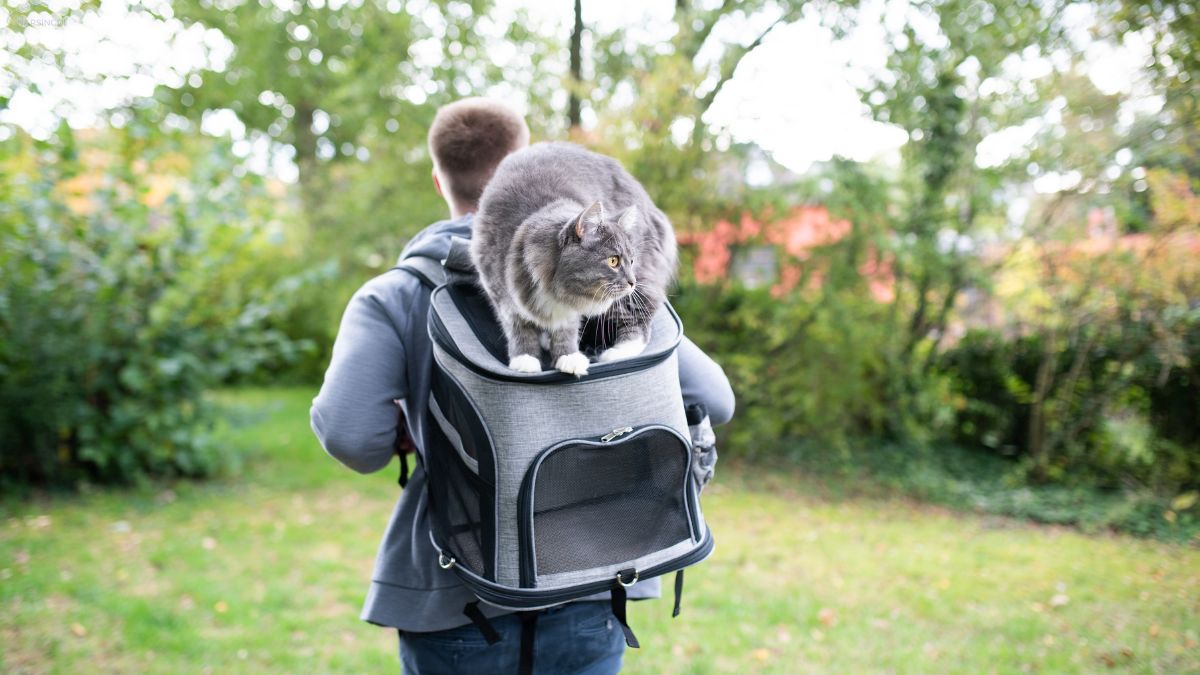Hiking with a cat might sound like an unusual adventure, but for many pet owners, it’s an exciting way to bond with their feline friends while exploring the great outdoors.
While cats are known for their independent and sometimes aloof nature, with the right preparation and mindset, they can be excellent companions on a hike.
How to hike with a cat? If you’re hitting a local trail or venturing into the wilderness, hiking with a cat requires a bit of extra planning.
From choosing the right gear to understanding your cat’s needs, this guide will help ensure that both you and your furry friend have a safe and enjoyable experience in nature.
Right cat For Hiking:
TOC
Not all cats are cut out for hiking, so it’s important to consider your cat’s personality, health, and comfort level with new experiences.
Personality and Temperament: Cats that are naturally curious, adventurous, and confident are typically better suited for hiking. If your cat is fearful of new environments, loud sounds, or unfamiliar people and animals, they may not enjoy the outdoor experience.
A hiking cat should be comfortable with change and open to exploring different surroundings. Additionally, active cats with a playful nature are better suited for the physical demands of hiking, while older or more sedentary cats might struggle to keep up.
Health and Fitness: Hiking can be physically demanding, so it’s crucial that your cat is in good health. Make sure they’re up-to-date on vaccinations and have no underlying health issues that could be aggravated by outdoor activities.
Older cats or those with joint problems may not be able to handle longer hikes, so always consult your vet before planning any trips. It’s important to ensure your cat can handle the physical exertion and that they’re fit enough to walk or explore outdoors.
Breed Considerations: While any cat can potentially enjoy hiking with proper training, certain breeds are more inclined to outdoor activities.
Breeds like Maine Coons, Bengals, and Abyssinians are known for their energetic and adventurous nature, making them good candidates for hiking. However, it’s important to remember that individual personality is key, regardless of breed.
Spend time observing your cat’s reactions to outdoor environments to see if they’ll be a good hiking companion.
Ultimately, the best hiking cat is one that’s curious, healthy, and comfortable with outdoor exploration.
How to hike with a cat:

Hiking with a cat is a unique and rewarding way to enjoy the outdoors together, but it requires some careful planning to ensure a safe and enjoyable experience for both you and your feline companion. But how to hike with a cat.
1. Essential Gear
Harness and Leash: A well-fitted harness designed for walking is essential to keep your cat secure while allowing them the freedom to explore. Make sure the harness is snug but comfortable, and avoid regular collars, as they are not meant for outdoor use.
Carrier or Backpack: For longer hikes, or if your cat gets tired, consider bringing a pet carrier or a backpack with an attached leash for easy transport.
Water and Snacks: Bring water for your cat, especially during warm weather. Collapsible bowls or portable water bottles are perfect for this. Also, pack some of your cat’s favorite treats to keep them energized.
Identification and Safety: Ensure your cat has a collar with an ID tag and is microchipped for added security. A basic first-aid kit for pets is a good idea, containing items like bandages and tick-removal tools.
2. Training and Preparation
Getting Used to the Harness: Start by introducing your cat to the harness indoors. Let them wear it for short periods and gradually increase the time. Once they’re comfortable, practice walking them in a secure area like your yard or around the house.
Gradual Outdoor Exposure: Before embarking on a hike, take your cat to a quieter outdoor space such as a park to help them get accustomed to new sights, sounds, and smells.
3. Choosing the Right Trail
Start with Easy Trails: Choose short, manageable trails to begin with. Avoid rough or challenging terrain until you know how your cat handles outdoor conditions.
Consider the Weather: Cats can be sensitive to heat and extreme weather, so try to plan your hikes during mild weather and avoid the hottest parts of the day. Be prepared for unexpected changes in weather as well.
4. On the Trail
Leash Control: Keep your cat on a leash at all times to prevent them from wandering off or encountering potential dangers. It also helps you keep control of your cat, especially around wildlife or other animals.
Stay Alert for Hazards: Be aware of potential risks like other animals, rough terrain, or toxic plants that your cat could encounter. Always keep an eye on your cat to ensure they’re safe.
Frequent Breaks: Hiking can be tiring for a cat, so make sure to take regular breaks. Offer water and allow your cat time to rest when needed.
With the right preparation and gear, hiking with your cat can be a memorable and enjoyable experience. By following these tips, you can ensure a safe and rewarding adventure for both you and your feline friend.
Post-Hike Care for Your Cat:
Hydrate and Rest: After the hike, provide water and a comfortable spot for your cat to rest. If they seem tired, allow plenty of time for recovery.
Check for Ticks and Injuries: Inspect your cat’s fur for ticks or any signs of injuries, and clean any wounds promptly to avoid infections.
Common Challenges:
Hiking with a cat can be a fun and rewarding experience, but it comes with its own set of challenges. Understanding these common issues and preparing for them will help ensure a smooth and enjoyable outing for both you and your feline companion.
1. Fear and Anxiety
Many cats are naturally cautious in new environments, and hiking can be overwhelming for them. The unfamiliar sounds, smells, and sights can cause anxiety or fear. To help your cat feel more comfortable, start with short hikes in quiet areas and gradually increase exposure to new environments. Bringing familiar items, like their favorite blanket or toy, can also provide comfort. Use positive reinforcement, such as treats and praise, to reward calm behavior and reduce anxiety.
2. Leash Training Challenges
Not all cats are used to wearing a harness or walking on a leash. Some may resist the harness at first, while others might not understand the concept of walking on a leash. Start training indoors with short sessions and use treats to reward them for wearing the harness. Allow your cat to explore the harness at their own pace, and never force them into it. Once they’re comfortable indoors, gradually move to a secure outdoor area for further training.
3. Overexertion
Unlike dogs, cats may not always recognize when they’re overexerting themselves. They might push through fatigue or become too tired to continue without showing obvious signs. Be mindful of your cat’s energy levels during the hike. Take frequent breaks to let your cat rest and hydrate. Keep an eye out for signs of exhaustion, such as slowed movements, panting, or reluctance to walk. If your cat seems tired, don’t hesitate to cut the hike short.
4. Wildlife and Other Animals
One of the biggest risks when hiking with a cat is their natural instinct to chase wildlife. A squirrel, bird, or other animal might trigger this instinct, causing your cat to run off. Always keep your cat on a leash to prevent them from darting off into potentially dangerous situations. Stay alert to wildlife or other hikers with dogs, as these encounters can be stressful or even risky for your cat. If necessary, use a backpack to carry your cat for safety in busy or wildlife-rich areas.
5. Weather and Environmental Conditions
Cats are sensitive to temperature extremes, so hiking in hot or cold weather can pose a risk to their health. Avoid hiking during the hottest part of the day, and make sure your cat has access to water to stay hydrated. In colder weather, dress your cat in a pet-friendly jacket to keep them warm, especially if they have short fur or are older. Always check the weather forecast before heading out to ensure the conditions are safe for your cat.
With patience, preparation, and the right approach, you and your feline friend can share many successful outdoor adventures.
Last Call:
- Hiking with a cat can be a fun and unique way to explore nature together, but it requires careful planning and preparation.
- By choosing the right gear, training your cat, and selecting the best trails, you can ensure both you and your feline companion enjoy a safe and memorable outdoor adventure.
- From dealing with common challenges to understanding your cat’s needs, the right approach makes all the difference.
Connect Us:
- Want more tips and inspiration for hiking with your cat?
- Join us on Pinterest for creative ideas, and subscribe to our newsletter for expert advice, updates, and exclusive content to make your outdoor experiences even better!
FAQs | how to hike with a cat
Q. Can any cat go hiking?
Not all cats are suited for hiking. Ideal hiking cats are curious, active, and comfortable with new experiences. Make sure your cat is healthy, enjoys outdoor activities, and doesn’t have mobility issues.
Q. What equipment do I need for my cat?
Key items include a secure harness and leash, a pet carrier or backpack for resting, water, snacks, and an ID tag. It’s also wise to carry a pet first-aid kit for emergencies.
Q. How do I prepare my cat for hiking?
Begin by getting your cat used to the harness indoors. Gradually introduce them to outdoor spaces, starting with quiet areas and short walks, to help them get comfortable.
Q. How long should I hike with my cat?
Start with short, easy hikes and monitor your cat’s energy and comfort. Take regular breaks for hydration and rest, and stop if your cat shows signs of fatigue or stress.
Q. What if my cat gets scared on the trail?
If your cat becomes frightened, stay calm and provide reassurance. Take a break in a quiet area to let them relax, or carry them in a backpack until they feel more comfortable.
Get More; Kayaking For Beginners

Its Aliza R. Khan, a passionate travel blogger from Bangladesh. With a knack for inspecting hidden gems and sharing travel tips, I love to inspires readers to explore the world with curiosity and adventure.










